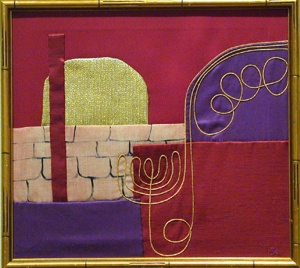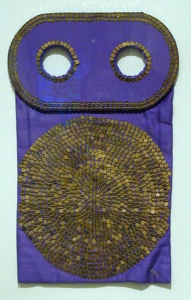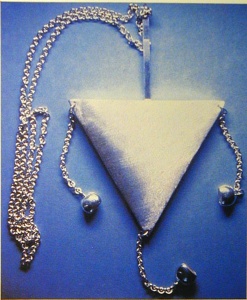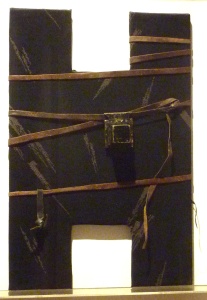55 Year Retrospective Exhibition
Ita Aber is a very unusual artist. Her work is in almost every major Jewish museum throughout the world. She is a master of the Fabric Arts, which is, by its very nature, an interdisciplinary field. As practiced by Ita Aber the fabric arts explodes in scale to include the diverse skills of embroidering, beadwork, sewing, appliqué, silkscreen, jewelry design, weaving, painting, sculpture and assemblage. The stunning range of her talents is reflected in the vast array of art work and Judaic objects she has produced. From wall hangings, jewelry and sculpture to Torah covers, ethrog boxes and purim masks, there is practically no area of Judaica or three dimensional art that is not represented here at the Broome Street Gallery in a retrospective covering 55 years of her very successful career. In addition, her diverse career is not limited to her work as an artist. She is also a conservator of textiles, an art historian, a curator, teacher and author of The Art of Judaic Needlework: Traditional and Contemporary Designs (Scribner 1979).
But perhaps the most intriguing aspect of Ita Aber’s talents is as a Conceptual Artist. Conceptual Art concerns itself with The Idea as the dominant aspect of the artwork. The technique, materials and aesthetics are all secondary to the beauty of An Idea.
The Ark Curtain (1979) is created of silk and cotton applique and embroidery. It proudly displays a Tree of Life that rises from two trunks, each curving gracefully towards the edges before they gesture inwards to one another in a gentle dance of branches and leaves with shimmering Hebrew letters floating and falling against a golden background. By placing the phrase Etz Haiim Hei on one of the trunks of the tree, Aber has set in motion the metaphors of the Torah as the tree of life, as the double staves of the sefer Torah and the multiple nature, perhaps male and female, of the Torah itself.

The Mizrach (1979) replaces the traditional word “mizrach” with an image that summons up what East means to all Jews. We see an image made of applique, paint and embroidery that is a simple evocation of the Har Habais and the Western wall painted on a pink fabric. Flat vibrant fields of purple and red maroon set the stage for a playful swirl of gold chain that loops into the collage from the right to fashion itself into a menorah and then exit in one continuous sensuous golden line. A swath of crimson fabric ascends from the base of Western Wall, through the golden dome and into the red sky symbolizing the path of our daily prayers. This mizrach not only points us in the right direction, it acts out in symbolic form the mechanics of our faith and prayers.
The holidays are not slighted in this exhibition, especially with Aber’s Hanukah Wall Hanging (1987) which depicts a golden dreidel on a rich field of royal blue spinning behind a nine branched organic menorah that is throwing off nine sets of golden beads. This powerful image manages to combine both the delight of the children’s game with the holy and spiritual mitzvah accomplished in eight days lighting. The gold and the vibrant blue fabrics convey the regal dynasty of the Hasomeans and our own elevation by celebrating Hanukah.
Ita Aber is an artist who delights in unconventional formats that provide unique and startling insights into Jewish life.

Untitled from 1979 seems to be a refashioned Torah mantle. The purple cotton satin form has been flattened out and the top oval and the two holes for the etz haiim have been edged with gold plated sterling sequins. A large circle of these luminous sequins is positioned on the front. In its abstract form the piece operates as both as the image of a flattened and dressed up Torah mantle or perhaps a Yemenite woman complete with a sequin veil. The confluence of ideas creates a metaphorical storm that transforms both images.

In 1987 Ita Aber created a “body ornament”, a silver plated triangular shape, with beads inside and clanging bells hanging on chain from the three corners entitled Esther/Vashti. It is an edition of 20 pieces of wearable sculpture. Both the collections of the Cooper Hewitt National Museum of Design and The Israel Museum own one of these sculptures. This anthropomorphic piece summons in a startling way the common femininity of the two pivotal women of Megillas Esther.
We are made aware of the subliminal links between Vashti and Esther, normally thought of as polar opposites, that recasts the Megillah in unexpected ways.

Perhaps the most radical and Conceptual work in this exhibition is entitled Black Eta from 1983. The very title requires explanation. In excavations in Israel and in the third century Dura Europos synagogue murals there have been found Greek letters on clothing from the late second Temple period. The garment was the pallium, the standard pull-over toga worn by both men and women. Some clothes worn by women had the Greek letter gamma, while others worn by men had the letter eta. Aber has taken these Greek symbol/letters, which she maintains were used to distinguish men’s clothing from women’s clothing according to halacha, and used them as ways to talk about male and female roles in Judaism. In this piece, the eta, which looks like an upright “H”, has been sheathed in black satin yarmulke fabric and bound with a pasul pair of tefillin. (The artist asked the late Gerer Rebbi z’l to rule on the permissibility of such usage. He maintained it was permissible). What has been accomplished with this very unusual work of art is that the artist has defined the Jewish male, symbolized by a Greek letter used by our ancestors, as symbolically clothed in mitzvas. His very being is a platform for serving God. By incorporating these religious objects themselves, the yarmulke and tefillin, into her work of art, she has fused the religious act and the artistic act into one event. This powerful Conceptual work bridges the conceptual gap between yiddishkeit, gender and art in one fell swoop.
It is in works like these that Ita Aber makes her mark as one of the major Jewish artists working today. We congratulate her on this retrospective and eagerly look forward to many more years of this kind of Jewish creativity.
Ita Aber, 55 Year Retrospective Exhibition
Broome Street Gallery
498 Broome Street,
New York, N.Y. 10013
(212) 877 7311
Until January 28, 2001
Published in The Jewish Press